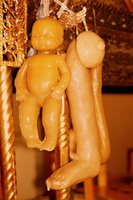Icons, Copper and Conquest
Cyprus has been a coveted piece of real estate since prehistoric times. Stone age artifacts reveal that human beings first settled here over 9,000 years ago. The island rose to prominence in the Bronze age, because of its rich copper deposits. More than 3,000 years ago, the Cypriots were already smelting copper into bronze, and trading with the great empires of the Middle East—the Egyptians, Babylonians and Hittites—who all called the island “Alasia.” But Ancient Greek mariners were on the horizon. There are signs of Minoan influence from at least the 15th century BCE, but the watershed event in the island’s culutral development was the arrival of the Mycenaeans from the Greek Peloponnese, around 1400 BCE. Then the essential Cypriot drama—the tension between eastern and western cultures—was set in motion.
After the arrival of the Mycenaeans, a majority Greek-speaking culture evolved on Cyprus. But the long sea voyage meant that most Cypriots would never see the Greek mainland. So customs often held on here longer than in other parts of the ancient Greek world. Heroic burial practices described by Homer were discovered in Cypriot tombs built centuries after those practices had been abandoned on the Greek mainland. And even today, Cypriot Greek retains some words from ancient Greek that haven’t been spoken in Greece for centuries.
Greek language and culture persisted on Cyprus during the long periods when foreign empires ruled the island from Assyria, Egypt and Persia. In 333 BCE, the Cypriots sided with Alexander the Great in his bid to free them from Persian control, only to become a battleground for Alexander’s successors when he died ten years later. The island became part of the Roman empire, succeeded by the Byzantine empire, which put the final stamp of Greek Orthodoxy on Cyprus.
pastiche of pagan and Christian symbols, some of the Roman gods in the mosaics are surrounded by halos. Elsewhere, shrines to local saints dot the island, including shrines that are literally dug out of the earth. To this day, the Orthodox church wields incredible influence over both spirtual and secular matters in the Greek-controlled part of Cyprus.
After the division of the Roman Empire into east and west, Cyprus was first ruled from Antioch in Syria, then from Constantinople, which administered Cyprus from the 5th century until the crusaders swept through the island at the end of the 12th century. Athens never directly ruled over Cyprus. So to many Greek Cypriots, the Byzantine period was their Golden Age. Some Greek Cypriots still whistfully refer to Istanbul as Constantinople.
But the Byzantine Empire had lost control of Cyprus long before Constantinople fell to the Turks in 1453. The Medieval history of Cyprus reads almost like a storybook, but to the island’s peasant population, it was no fairy tale.
The early crusades bypassed Cyprus. But during the Third Crusade, the island fell to England’s King Richard I (1157-1199), better known as Richard the Lionheart. In 1191, a ship carrying his sister and his fiance, the princess Berengaria of Navarre, moored off the coast of Limassol. The Byzantine ruler of Cyprus denied them provisions, so Richard defeated the Byzantine forces and conquered Cyprus out of revenge. He promptly married Berengaria in Limassol, and then set sail for the Holy Land.
Richard had no real interest in Cyprus, so he sold it to the Knights Templar. But the Templars found this a poor bargain, so they returned it to Richard, who quickly resold it to Guy de Lusignan, a minor French nobleman. Lusignan aligned himself with the Knights Hospitallers of St. John. So within a very short timespan, Cyprus had been plundered, taxed, sold and resold by most of the major crusaders, who essentially treated it as a consolation prize for the loss of Jerusalem.
By all accounts, the Lusignans were a mediocre bunch. But their possession of the last European outpost before Jerusalem allowed them to marry into the major royal houses of Europe. During the 14th century, Farmagusta, their stronghold port, which is now on the Turkish side of the island, became one of the richest cities on earth. It was practically a required stopover for crusaders, a hub of Christian refugees from the east, and a busy trading port. The Venetians assumed power from the Lusignans in 1474, when the Lusignan king and his infant son died mysteriously within a year of the king’s marriage to Caterina Cornaro, a Venetian noblewoman. The Venetians clung to power in Cyprus for another century.
For nearly 400 years, the indigenous Cypriots were essentially the serfs of the Catholic lords and their knights. They toiled in the fields—cultivating olives, wheat and vineyards—including the grapes for a sweet dessert wine that is still called “Commandaria” for the Medieval fortress nearby. The Lusignans and Venetians dotted the island with fortresses and walled cities. Their most dramatic legacy is the vast Medieval wall that encircles Nicosia. Cyprus has always been a difficult place to defend.
likely descendants of the Venetians. There’s also a small community of Armenians, who have their own Christian church. And there’s a close-knit community of Maronites—one of the eatern rites of the Roman Catholic church—who may have arrived in Cyprus from their homeland in Lebanon as early as the 7th century.
| Learn More About Cyprus: Overview > > Until 1950 < < Since 1950 | During the long sunset of the Ottoman Empire, the Turks ceded control of Cyprus to the British Empire. British forces landed in the Cypriot port of Larnaca in 1878, and took control of the island without firing a single shot. Many Greek Orthodox Cypriots welcomed the |
|---|
tCr










0 Comments:
Post a Comment
<< Back to tCr Home